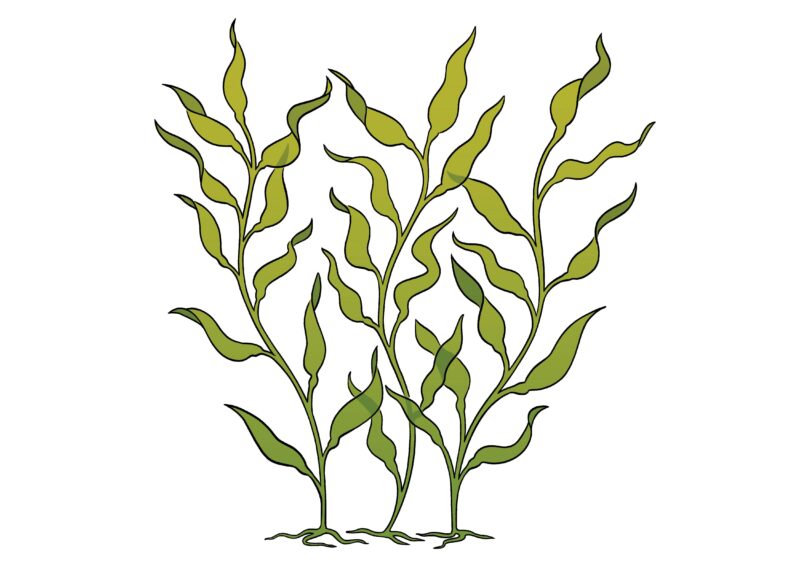FEATURES:
- Between five and twenty-five million years old
- Carbon-negative
- Makes clouds
Picture George Eliot: long face, long nose, dressed as a man. She and her common-law husband, George Lewes, are both in “a wide-awake hat” and “an old coat, with manifold pockets in unexpected places, over which is slung a leathern case, containing hammer, chisel…” They also each wield two knives, and wear “trousers warranted not to spoil.” It is the summer of 1856, on the craggy Devon coast, and Eliot has recently adopted Lewes’s surname. Together, they haunt tide pools, and Eliot discovers the “difference… between having eyes and seeing.” They “scramble,” she writes, over a shoreline that is “nothing but huge boulders and jutting rocks.” Here, she falls in love. “Quite in love,” she puts it, “with sea-weeds.” She adds, “I shall never forget their appearance… the dark olive fronds of the Laminariae.”
Me too, with the same seaweed: Laminaria digitata—kelp.
I come to it after an apocalyptic email warns me to eat seaweed. The missive invokes the war in Ukraine and threats to its nuclear reactors. The New York Times reports that Russian troops have dug trenches in Chernobyl’s radioactive dirt, sending Geiger counters clicking madly. Kelp is the most iodine-rich food in the world, so hopefully protection.
I start eating more seaweed, much more, and begin to spend hours, days, avoiding writing, googling seaweed, following every seaweed-fact rabbit hole. Kelp is a vague name for certain brown seaweeds, I learn. Seaweeds themselves are macroalgae, and there are three kinds: red, green, and brown. Red and green seaweeds are plants and brown is a chromist. Red and green represent the oldest forms of plant life: green seaweed 1 billion years old; red even older, 1.6 billion years. Kelp has been around for between five and twenty-five million years. Not vascular plants, these macroalgae are permeable to their environment, allowing them to absorb nutrients at a rate higher than those of terrestrial plants. There are thirty types of laminaria alone, and some grow more than a foot a day. The Laminaria digitata has blades like fingers—that is, if fingers were slick, brown, and leathery.
There is talk that giant kelp forests could halt climate change, because seaweed is carbon-negative, and kelp grows so quickly. It can clean heavy metals and nuclear waste from ocean water, and there are heady reports of seaweed-based bioplastics and biofuels. Not to mention the litany of ailments kelp might cure: HIV, HPV, cancer (colon and breast). It is anti-tumor, anti-obesity, and fights diabetes (goodbye, Ozempic). It’s antimicrobial, so no more antibiotics (or antibiotic resistance) and might even cure COVID, thanks to the iodine it contains.
All the scientific studies are driven by breaking kelp into singular elements, things to extract to fix ourselves and our world, rather than seeing how its constituent parts work together in one organism—and the sheer awe that understanding can produce.
None of this research existed in Eliot’s time. All she had there on the rocks was the looking, the wonder, and the love, her eyes opened. That summer she is still Mary Ann Evans, not yet Eliot, and, dressed as a man as she searches the shore, she’s free. My favorite thing about laminaria—it makes clouds. When exposed to the sun and waves at low tide, kelp releases iodide to reduce the stress, and this iodide seeds clouds. I see Eliot bathed in kelp-clouds, her own stress released, and I imagine this is what frees her, during these months in Devon, to begin writing fiction. I am sure there are long walks, and talks about this with Lewes. The two share everything, and as a novelist she becomes George Eliot, taking his first name in her professional life, as she has taken his last name in her personal one. But just as I have turned to seaweed in my anxiety and procrastination, I picture her in the clouds, and as she searches for seaweed, she, too, is released from whatever fears she’s had. This vision makes me love seaweed the most: these cloud-creating algae helping Eliot write her novels.





